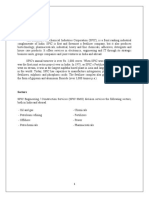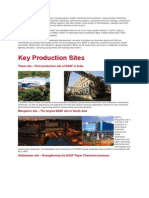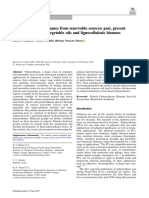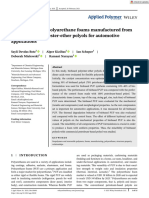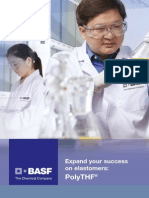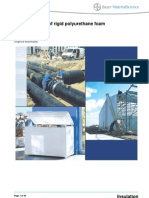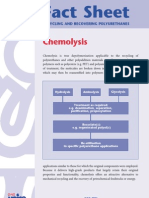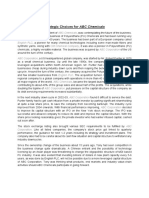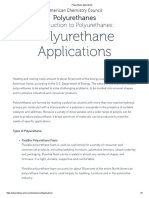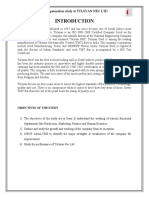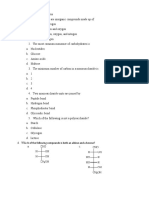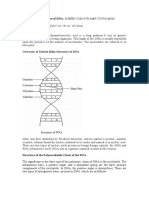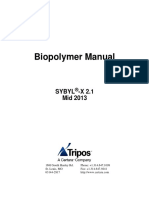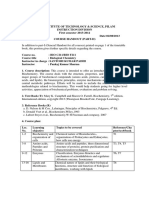Executive Summary: 0.1 National Scene
Executive Summary: 0.1 National Scene
Uploaded by
RSCopyright:
Available Formats
Executive Summary: 0.1 National Scene
Executive Summary: 0.1 National Scene
Uploaded by
RSOriginal Description:
Original Title
Copyright
Available Formats
Share this document
Did you find this document useful?
Is this content inappropriate?
Copyright:
Available Formats
Executive Summary: 0.1 National Scene
Executive Summary: 0.1 National Scene
Uploaded by
RSCopyright:
Available Formats
EXECUTIVE SUMMARY
Polyols are used to manufacture polyurethane, which find extensive use in the automotive, construction, refrigeration and other industrial sectors. 0.1 NATIONAL SCENE The polyols produced in India are glycols of high molecular weight of polyether, polyester and hydrocarbon types. Polyethene glycol is primarily produced to meet the demand of emulsifiers and surfactants and hardly any of it is used in the manufacture of polyurethane. But, 98% of the other polyethene polyols like polypropylene glycol are used in the production of flexible or rigid foams. Polybutadiene based polyols are made mainly for use as solid rocket propellant binders. Before 1950, Dai-Ichi Karkaria and Castrol (I) Ltd., were producing urethane grade polyols. Now, there are some more industries which have commenced manufacture of polyols for polyurethane. These industries are Manali Petrochemicals Ltd, UB Petroproducts Ltd., Shivathene Linopack Ltd.. NOCIL. Malabar Polyols and Expanded Incorporation. Manali Petrochemicals and UB Petroproducts have started production of polyether polyol in 1990. Manali Petrochemicals Ltd. has technical collaboration with M/s ARCO. USA. while UB Petroproducts has one with M/s Pressindustria A.G., Switzerland. There are the only two units in the country manufacturing polyols from the grass root level, using propylene as the raw material. Propylene is converted to propylene oxide and then into polyols, whereas all the other units are vegetable oil based or else they start with propylene oxide. The polyols are blended with necessary catalysts, surfactants and blowing agents and mixed in the right proportion with isocyanates to yield foam of predictable quality. (iii)
Conventional slab stock foam manufacturers have sufficient expertise to blend the necessary catalysts and chemicals. Such customers purchase polyols directly. However, for the market, blended polyols and rigid grades alone are sold in the suggested mix ratio of isocyanates, togetherwith typical data of machine properties like cream time, gel time and properties of the foam thus generated. MPL and UB, reportedly have sufficient expertise to make the systems and necessary test equipment, equivalent to that of any international company. 0.2 0.2.1. MANUFACTURE Polyether Polyol Commercially, polyether polyol is manufactured by ethoxylation/ propoxylation of a polyhydric alcohol in the presence of a catalyst. The polyhydric alcohols used are ethylene glycol, Dipropylene glycol, diethyelene glycol, glycerol. Carbohydrates such as Sorbitol, Mannitol, triethanol amine, sucrose are also used as polyhydric alcohol in the preparation of polyether polyols for making polyurethane foam. 0.2.2 Polyester Polyol The polyester polyols used in the manufacture of polyurethane are required to be hydroxyl terminated. Polyester polyol is prepared by reacting an excess of the stoichiometric amount of difunctional glycol with dibasic acid. The manufacture is usually carried out through a batch process. The most widely used polyester polyol is polyethylene adipate. 0.2.3 Castor Oil Based Polyol Castor oil is the most widely used polyol in the manufacture of rigid one shot polyurethane foam. Castor oil is a triglyceride of ricinoleic acid (iv)
which contains hydroxyl group at its 12th carbon position. There is one disadvantage in using castor oil based polyols in the manufacture of rigid foam, because of poor reactivity of the secondary hydroxyl group. The foam produced from castor oil has poor compressive strength. For making castor oil polyols suitable for polyurethane foam, it is often treated with polyhydroxy compounds such as ethanol amine, glycerin etc. by way of alcoholysis. 0.2.4 Hydrocarbon Polyols (Hydrozy Terminated Polybutadiene) Polyols having hydrocarbon backbone (HTPB) are mainly required for use in solid propellant binders. These are made by free radical polymerisation of butadiene gas using hydrogen peroxide as initiator or by anionic polymerisation of butadiene. The major manufacturers of HTPB are M/s ARCO, USA and Japan Synthetic Rubber, Japan. In addition, hydroxyl terminated natural rubber (HTNR) has also been developed for use in fuel rich propellants, starting from natural rubber and hydrogen peroxide. 0.3 INTERNATIONAL SCENE A major part of the world's polyols production is shared by the two polyols namely Polyether and Polyester polyol. The production capacity stands at 3.5 million tonnes and a growth rate of 4% per annum is forecast. There are no serious health hazards associated with polyols and their raw materials. Dow Chemicals, Bayer, BASF, Union Carbide are some of the major producers of Polyols. Dow Chemicals claims more than 20% of the world's manufacturing capacity for polyols. Main producers of polymer polyols are Union Carbide Corporation, Bayer AG and Mitsui Nisso Corporation. Polymer polyol is preferred by many polyurethane foamers due to its lower viscosity, light colour and high load bearing characteristics. 0.4 LATEST TECHNOLOGY Polymer polyols are a completely new type of polyol made by graft polymerization of monomers having a vinyl group on to polyether (v)
polyols. By using this polymer polyol, it is possible to obtain features which can not be obtained by polyether polyol alone such as high loadbearing properties, excellent strength and high resilience. Polymer polyols are largely used in manufacturing flexible slab-stock foams and semirigid foams such as bumpers and also to improve mouldability of foams. Now acrylonitrile based third generation polymers are being used in these polymer polyols. Of course, high resileince slab stock is yet to find acceptance in the primary market because of its high cost. Rigid foams like bumpers, are also made entirely using reactive polyols. 0.5 DEMAND AND GROWTH In India, polyols are consumed along with isocyanates by polyurethane (PU) foam manufacturers. Polyether polyol is the most widely used polyol to manufacture both rigid and flexible polyurethane foam. The total demand of polyols in India is approximately 12,000 TPA. Unlike in the western countries where rigid PUs have a larger share of market, flexible PUs have better market in India. In India, mattress manufacturers are the major consumers of these polyols. Apart from flexible PUs, other major sectors of consumption of polyols are shoe soles, coating insulation etc. Before 1990, the total demand of polyols was met through import. Some companies have come in the field of manufacture of polyols and some companies like UB Petroprodcuts Ltd., Manali Petrochemicals Ltd., have already commenced production of polyols. Rigid polyurethane foam is also used in India for refrigerator insulation, interior panelling, wing tips, fuse large insulation, radar covers etc. of air crafts, car bumpers, instrument panels, stearing wheels, roof insulation of automobiles etc. Recently, Urethane India Ltd. (UIL) a subsidary of Chemicals and Plastics India Ltd. have started providing thermoplastic polyurethane resins (TPUs) in collaboration with M/s B.F. Goodrich Chemical Group. For making TPUs, they use imported polyols and isocyanate. (vl)
0.6
HEALTH & SAFETY FACTORS Polyols used in manufacture of polyurethane have very low toxicity. High molecular weight polyether polyols derived from propylene oxide and copolymers of propylene oxide and ethylene oxide have a low oral toxicity. Polyols are not irritating to the eyes & skin. Similarly, polyester polyols also have low toxicity. Although polyols have low toxicity, the raw material from which they are manufactured e.g. ethylene oxide, propylene oxide are highly toxic. Ethylene oxide is toxic both in gaseous and liquid form. The current TWA is 1 ppm. Like EO, Propylene oxide is also a toxic material. The AGGIH recommends an 8h-TWA limit of 20 ppm.
0.7
SPECIFICATIONS There are no Indian standards/specifications available for testing of polyols. However, there are specifications available for polyurethane foams.
0.8
RESEARCH AND DEVELOPMENT R & D Work is going on for development of technologies for polyols in very few National Institutes and Laboratories in India. Vikram Sarabhai Space Centre (VSSC) has developed technologies for castor oil based polyols & hydroxy terminated polybutadiene (HTPB) polyols and have transferred the technology to three companies. VSSC also has developed a technology for the manufacture of hyroxyl terminated natural rubber (HTNR) and epoxidized HTPB for use in solid propellants and adhesives respectively. IICT, Hyderabad is going to start research work on development of substitute for CFCs. Polyol producing industries have elaborate in-house R & D facilities, Manali Petrochemicals Ltd, UB Petroproducts have fully equipped laboratories for carrying out research in Polyols & Polyurethane systems. They are paying their collaborators for technical and R&D support.
(vii)
0.9
CONCLUSIONS AND RECOMMENDATIONS
Polyols are required in the manufacture of polyurethanes which find wide applications in the manufacture of flexible, semi rigid, moulded and rigid foams. Other important applications are in the manufacture of thermoplastic elastomers, coatings, adhesives, artificial leather and medical devices. Manali Petrochemicals and UB Petroproducts Ltd. are the two major units involved in the manufacture of polyols.Shivathene Linopack Ltd. makes vegetable oil based polyols. Vikram Sarabhai Space Centre (VSSC), Trivandrum has developed the process for hydroxy terminated polybutadiene and a castor oil based polyester type of polyol. Moulded grade polyols, soft polyols and polyol based polyurethane systems need to be developed in the country. The manufacturing units have active R&D programmes under various stages of progress. The national laboratories have not taken up any serious work in this area. Only VSSC has undertaken work in this area. All the raw materials required in the manufacture of polyols are not available in sufficient quantities indigenously. Besides. TDI and MDI, which are also primary raw materials required for the manufacture of polyurethane together with polyols. are not manufactured indigenously. Several grades of polyols are also yet to be manufactured indigenously. These are some of the gaps identified.
RECOMMENDATIONS
The following recommendations emerge : As isocyanates are largely required in the manufacture of foams, together with polyols, and are not currently being manufactured in the country, priority need be given to initiate manufacture of the same. (viii)
All required grades of polyols need be manufactured in the country. Manufacturers need take necessary action. Growth areas and export potential need be tapped by the manufacturers. Ethylene oxide is required in the manufacture of polyols. As there is a demand supply gap in ethylene oxide, steps need be taken to step up its production. Effects need be stepped up for development of soft polyols to be used in CFC free polyurethane foams.
(ix)
You might also like
- West Africa Offshore MapDocument1 pageWest Africa Offshore MapRS100% (1)
- Production of Polyurethane (Proposal)Document16 pagesProduction of Polyurethane (Proposal)YnnoNo ratings yet
- Polyurethane (PU) : HistoryDocument28 pagesPolyurethane (PU) : HistoryPrithviraj Daga83% (12)
- DSCL KotaDocument27 pagesDSCL KotaAshu Reswal0% (1)
- Control Valve Data SheetDocument2 pagesControl Valve Data SheetRS100% (1)
- Productionof Flexible Polyurethane Foamusing Soya Bean Oiland Palm Kernel Oilas Surfactantand Polyol RespectivelyDocument10 pagesProductionof Flexible Polyurethane Foamusing Soya Bean Oiland Palm Kernel Oilas Surfactantand Polyol Respectivelysaver mendleevNo ratings yet
- Spic Group ProfileDocument15 pagesSpic Group ProfileAmbrose JayasinghNo ratings yet
- Polyurethane ManufacturerDocument4 pagesPolyurethane ManufacturerPratibha GuptaNo ratings yet
- PolyurethaneDocument13 pagesPolyurethaneAnwesh Satapathy100% (1)
- History: Polyurethane (Often Abbreviated PUR and PU) Is A Commonly EncounteredDocument3 pagesHistory: Polyurethane (Often Abbreviated PUR and PU) Is A Commonly EncounteredM Vinoth KumarNo ratings yet
- BASF in India Manufactures PolymersDocument3 pagesBASF in India Manufactures PolymersmeetsarkarNo ratings yet
- How Polyurethane Is Made - Material, Production Process, Making, History, Used, Processing, Parts, StepsDocument4 pagesHow Polyurethane Is Made - Material, Production Process, Making, History, Used, Processing, Parts, Stepsziradagreat539No ratings yet
- Pu ElastomerDocument34 pagesPu ElastomerSuyash TrivediNo ratings yet
- Polyols and Polyurethanes From Renewable Sources: Past, Present and Future-Part 1: Vegetable Oils and Lignocellulosic BiomassDocument22 pagesPolyols and Polyurethanes From Renewable Sources: Past, Present and Future-Part 1: Vegetable Oils and Lignocellulosic BiomassDevarshi ModiNo ratings yet
- PolyurethaneDocument16 pagesPolyurethaneপ্রজা পতিNo ratings yet
- Bote 2021Document15 pagesBote 2021ferit.ay.1967No ratings yet
- Notes On PeterochemicalsDocument8 pagesNotes On Peterochemicalsyashkumar987125No ratings yet
- Soy Based PlasticsDocument4 pagesSoy Based PlasticsA MahmoodNo ratings yet
- Bio-Based PolyurethaneDocument2 pagesBio-Based PolyurethaneDoris de GuzmanNo ratings yet
- Polyurethane Foam ApplicationDocument5 pagesPolyurethane Foam ApplicationMichelle EvelynNo ratings yet
- Polyol QuestionnaireDocument2 pagesPolyol QuestionnaireAnindya RayNo ratings yet
- Plastic IndustriesDocument20 pagesPlastic IndustriesOm PatelNo ratings yet
- UrethaneDocument14 pagesUrethaneMuhammad Yazid TharmiziNo ratings yet
- Total Polymer Consumption in Automobile Sector in Pune Region Appl Industries Pune by Mrinal Khajuria MarketingDocument57 pagesTotal Polymer Consumption in Automobile Sector in Pune Region Appl Industries Pune by Mrinal Khajuria MarketingSwapnil WagadreNo ratings yet
- PU Chemical WeeklyDocument4 pagesPU Chemical WeeklyOmprakash Shrinivas YemulNo ratings yet
- Lecture 2production of PolyolefinsDocument12 pagesLecture 2production of Polyolefinsrk_gummaluri5334No ratings yet
- Polyurethane: 1 HistoryDocument10 pagesPolyurethane: 1 Historycaturro77No ratings yet
- PolypropyleneDocument18 pagesPolypropylenepratik4380No ratings yet
- Basf PolyTHFDocument12 pagesBasf PolyTHFadrianrdeitosNo ratings yet
- 2 Polyurethane Foam Chemistry: 2.1 HistoryDocument11 pages2 Polyurethane Foam Chemistry: 2.1 HistoryROVIC JUSTINE DAGDAGANNo ratings yet
- Propylene Glycol PDFDocument10 pagesPropylene Glycol PDFGovindanayagi PattabiramanNo ratings yet
- Total Polymer Consumption in Automobile Sector in Pune Region Appl Industries Pune MarketingDocument57 pagesTotal Polymer Consumption in Automobile Sector in Pune Region Appl Industries Pune MarketingMustafa S TajaniNo ratings yet
- Sanyo Chemical Product Outline: ProductlistDocument4 pagesSanyo Chemical Product Outline: ProductlistA MahmoodNo ratings yet
- Global Scenario On Toluene Diisocyanate (TDI) : Nandini Consultancy CenterDocument13 pagesGlobal Scenario On Toluene Diisocyanate (TDI) : Nandini Consultancy Centeranuj242100% (1)
- PolyurethaneDocument27 pagesPolyurethaneHarshavardhan100% (1)
- Calculos de Poliuretano RigidoDocument46 pagesCalculos de Poliuretano Rigidosescobar86100% (1)
- BASF PolyTHF For ElastomersDocument7 pagesBASF PolyTHF For Elastomersnatan.ed.claroNo ratings yet
- Acquisition of Ipcl by RelianceDocument18 pagesAcquisition of Ipcl by RelianceHasmukh JadejaNo ratings yet
- Eco Profile PU PDFDocument19 pagesEco Profile PU PDFayman emmadNo ratings yet
- Graft Polymer Polyether Polyols Employing A Silica PDFDocument15 pagesGraft Polymer Polyether Polyols Employing A Silica PDFDenisaMVNo ratings yet
- Ailing Indian PVC IndustryDocument5 pagesAiling Indian PVC IndustryCharu SharmaNo ratings yet
- 5-Recent Advancement in Plant Oil Derived Polyol-Based Polyurethane Foam For Future Perspective A ReviewDocument23 pages5-Recent Advancement in Plant Oil Derived Polyol-Based Polyurethane Foam For Future Perspective A ReviewSolmazNo ratings yet
- TSR 018Document11 pagesTSR 018ilker YILMAZNo ratings yet
- Flexible FoamDocument18 pagesFlexible Foamakukerank100% (1)
- 10 1016@j Eurpolymj 2016 10 012Document28 pages10 1016@j Eurpolymj 2016 10 012syamsutajriNo ratings yet
- Chap12 PDFDocument44 pagesChap12 PDFYassine OuakkiNo ratings yet
- Study of The Production of Polyesters For PU at Pilot Plant Scale PDFDocument76 pagesStudy of The Production of Polyesters For PU at Pilot Plant Scale PDFCarlotta C.No ratings yet
- Sheela Foam TRNG ReportDocument27 pagesSheela Foam TRNG ReportAbhijeetKumar100% (2)
- Chemo Lys IsDocument6 pagesChemo Lys IsarfpowerNo ratings yet
- ABC ChemDocument9 pagesABC ChemVatsal DaveNo ratings yet
- 1.introductory ConceptsDocument33 pages1.introductory ConceptssniremapakNo ratings yet
- Polyurethane ApplicationsDocument6 pagesPolyurethane ApplicationsGabriel DiazNo ratings yet
- Synthesis and Characterization of Polyesters Derived From Glycerol and Phthalic Acid2007materials ResearchOpen AccessDocument4 pagesSynthesis and Characterization of Polyesters Derived From Glycerol and Phthalic Acid2007materials ResearchOpen AccessPaulo Venicio Alves VieiraNo ratings yet
- Soy Based Thermoset PlasticsDocument3 pagesSoy Based Thermoset PlasticsA MahmoodNo ratings yet
- An Organization Study at TULSYAN NEC LTD: Objectives of The StudyDocument81 pagesAn Organization Study at TULSYAN NEC LTD: Objectives of The StudyShowmiya MahaNo ratings yet
- Polyurethanes: Science, Technology, Markets, and TrendsFrom EverandPolyurethanes: Science, Technology, Markets, and TrendsRating: 1 out of 5 stars1/5 (1)
- Forest Products in the Global Bioeconomy: Enabling Substitution by Wood-Based Products and Contributing to the Sustainable Development GoalsFrom EverandForest Products in the Global Bioeconomy: Enabling Substitution by Wood-Based Products and Contributing to the Sustainable Development GoalsNo ratings yet
- Biopolymers: New Materials for Sustainable Films and CoatingsFrom EverandBiopolymers: New Materials for Sustainable Films and CoatingsDavid PlackettNo ratings yet
- Reaching Zero with Renewables: Biojet FuelsFrom EverandReaching Zero with Renewables: Biojet FuelsNo ratings yet
- Circular Economy: Assessment and Case StudiesFrom EverandCircular Economy: Assessment and Case StudiesNo ratings yet
- 2/23/2014 Karnataka Tourism 1Document15 pages2/23/2014 Karnataka Tourism 1RSNo ratings yet
- India Hydrocarbon Vision - 2025Document10 pagesIndia Hydrocarbon Vision - 2025RSNo ratings yet
- E&P Spending To Set A New Record at $644 BillionDocument6 pagesE&P Spending To Set A New Record at $644 BillionRSNo ratings yet
- 43 - Gas-Injection Pressure Maintenance in Oil ReservoirsDocument19 pages43 - Gas-Injection Pressure Maintenance in Oil Reservoirsrizal tri susiloNo ratings yet
- EPC Contractors:: Changing With The IndustryDocument19 pagesEPC Contractors:: Changing With The IndustrymdlayeequeNo ratings yet
- Flow Meter SelectionDocument5 pagesFlow Meter SelectionRSNo ratings yet
- Material Safety Data Sheet CBFSDocument4 pagesMaterial Safety Data Sheet CBFSRSNo ratings yet
- Moc ChartDocument8 pagesMoc ChartRSNo ratings yet
- Vacuum FiltrationDocument9 pagesVacuum FiltrationRSNo ratings yet
- ScrubberDocument8 pagesScrubberRS50% (2)
- API Vs ANSI PumpsDocument6 pagesAPI Vs ANSI PumpsRS100% (2)
- Your Valve Partner: Compact Mounting Modular DesignDocument58 pagesYour Valve Partner: Compact Mounting Modular DesignRSNo ratings yet
- Functional FoodDocument14 pagesFunctional FoodSumeyya Binte Bockthier100% (1)
- Haloalkanes and Haloarenes CBQsDocument22 pagesHaloalkanes and Haloarenes CBQsAnanya AryaNo ratings yet
- NO Nama Obat Harga Sisa Tanggal Expired: TabletDocument7 pagesNO Nama Obat Harga Sisa Tanggal Expired: TabletKlinik PKBI AcehNo ratings yet
- Org Chem Final ReviewerDocument7 pagesOrg Chem Final ReviewerblessaNo ratings yet
- IUPAC Nomenclature of Organic CompoundsDocument15 pagesIUPAC Nomenclature of Organic Compoundsapi-1986055092% (24)
- Petroleum Industry PDFDocument15 pagesPetroleum Industry PDFVineet Sharma33% (3)
- Rencana Kebutuhan Obat Pada Fasilitas Kesehatan Tingkat Pertama (FKTP) TAHUN 2021Document17 pagesRencana Kebutuhan Obat Pada Fasilitas Kesehatan Tingkat Pertama (FKTP) TAHUN 2021Chia paewaNo ratings yet
- Quiz CarbDocument7 pagesQuiz CarbKeith AquinoNo ratings yet
- UDHA - (Sem-11) - Chem: Marks 70 Time: Hours Group-A Answer From Group-B Questions From Group-C. Margin Their WordsDocument5 pagesUDHA - (Sem-11) - Chem: Marks 70 Time: Hours Group-A Answer From Group-B Questions From Group-C. Margin Their WordsGaurav KumarNo ratings yet
- Worksheet 3 - Carbohydrates (Online Class)Document13 pagesWorksheet 3 - Carbohydrates (Online Class)Akeysha CarreonNo ratings yet
- Organic Reactions Summary SheetDocument2 pagesOrganic Reactions Summary Sheetknprop134No ratings yet
- Brochifar Plus Kap 35664 100 1Document15 pagesBrochifar Plus Kap 35664 100 1rio1995No ratings yet
- Module 1 - Central DogmaDocument8 pagesModule 1 - Central DogmaAnanya SinghNo ratings yet
- Problems Fluid MosaickeyDocument7 pagesProblems Fluid MosaickeyBatrisyia AdNo ratings yet
- LaporanDocument214 pagesLaporankadek sariNo ratings yet
- Montapacking Lelystad B.V. Zuiveringweg 21 8243PZ Lelystad NetherlandsDocument7 pagesMontapacking Lelystad B.V. Zuiveringweg 21 8243PZ Lelystad NetherlandsMuhammad Ameer Hamza KayanNo ratings yet
- A Direct Method For Fatty Acid Methyl Ester (FAME) SynthesisDocument40 pagesA Direct Method For Fatty Acid Methyl Ester (FAME) Synthesisanuradha.d.bhat9860No ratings yet
- Double Helix Structure of DNADocument4 pagesDouble Helix Structure of DNARam SinghNo ratings yet
- Fatty Amine Ethoxylates and ItDocument3 pagesFatty Amine Ethoxylates and ItRizki RamadhanNo ratings yet
- Biopolymer ManualDocument340 pagesBiopolymer ManualGerman EsalasNo ratings yet
- Reaction 20230305 1400Document92 pagesReaction 20230305 1400khushbu patelNo ratings yet
- BiochemistryDocument2 pagesBiochemistrygauravNo ratings yet
- 12 - Nucleotide MetabolismDocument53 pages12 - Nucleotide MetabolismFrankenstein MelancholyNo ratings yet
- Soap Based Chain Conveyor Lubricant - Basf Wyandotte CorporationDocument7 pagesSoap Based Chain Conveyor Lubricant - Basf Wyandotte CorporationShaara NeyNo ratings yet
- Isomerism - DPP-01 (Of Lecture 02) - Yakeen 3.0 2024Document3 pagesIsomerism - DPP-01 (Of Lecture 02) - Yakeen 3.0 2024bikrampaul021No ratings yet
- Contributors Preface: 1 Theoretical Aspects of Microwave Dielectric Heating 1Document5 pagesContributors Preface: 1 Theoretical Aspects of Microwave Dielectric Heating 1Ruswanto Ais ZalfaNo ratings yet
- Food IndustryDocument14 pagesFood IndustrySarfrazNo ratings yet
- SLG Chem 3 LG 5.6 Review of Nucleic Acids Structure and Functions (Part I)Document7 pagesSLG Chem 3 LG 5.6 Review of Nucleic Acids Structure and Functions (Part I)franzachilleslindayagNo ratings yet
- Thomas Calculus 14th Edition (1) - 1Document3 pagesThomas Calculus 14th Edition (1) - 1hafizabdullahmbaNo ratings yet
- Alcohol Phenol Ether Revision NotesDocument3 pagesAlcohol Phenol Ether Revision NotesAkku AkkuNo ratings yet






